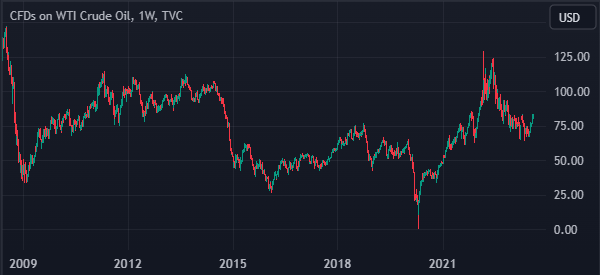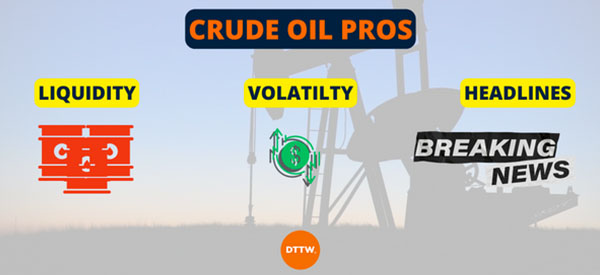Crude Oil is one of the most liquid commodities in the market. According to the CME Group, more than $80 billion worth of oil is traded on a daily basis. This Crude Oil is used to power vehicles and machines around the world.
This liquidity has led to increased volatility in the oil futures market as investors use it as a hedging tool. Just think about this: today, oil is one of the main causes of market movements! In 2015, oil prices went down which led to the S&P and Dow to go down.
The price of crude oil plunged in the first months of the Covid-19 pandemic as demand dried around the world. At some point, the price crashed to the negative territory before making a comeback.
Oil then bounced back after Russia invaded Ukraine in 2022. In this article, we will look at some of the basics of day trading crude oil.


Why crude oil matters
Crude oil is one of the most important commodities in the world. It is a crucial product that powers the world as we know it. As a result, over 98 million barrels of oil are consumed every day. Therefore, there are several reasons why many traders focus on trading crude oil.
First, crude oil is a highly liquid financial asset, meaning that you can easily buy and sell it in the market. This liquidity is an important part because it lowers the cost of transactions.
Second, oil is a highly volatile commodity, which benefits traders seeking to benefit from short-term movements. Third, it is always in the news, making it an interesting asset to trade. This is unlike other commodities like corn, soybeans, and wheat.


Further, crude oil is provided by most online brokers. They provide it in the form of options, futures, or contracts for difference (CFD).
Brent vs West Texas Intermediate
A common question is on the difference between Brent and West Texas Intermediate. The difference is that Brent is the international benchmark of crude oil while WTI is the United States one.
These benchmarks happen because oil is not the same. This happens across all commodities, including wheat and corn. As such, different countries price their oil differently.
In addition to WTI and Brent, there are other oil benchmarks. For example, there is the Urals, which refers to Russian oil and Dubai, which is Middle East one.
Ways to trade oil
There are three main ways to trade crude oil. First, you can trade crude oil in the form of a CFD. A CFD is a financial derivative that tracks the price of crude oil. These products are mostly provided by companies from around the world except from the US.
Second, you can trade oil futures and options. These are financial derivatives that let you place calls and put options. Futures contracts give you the right to buy or sell oil at a later date. Options, on the other hand, give you the right but not the obligation to buy the asset.
Third, you can trade oil companies or exchange-traded funds (ETFs). Some of the most popular funds in the industry are the United States Oil Fund (USO), Invesco DB Oil Fund (DBO), and ProShares Ultra Bloomberg Crude Oil (UCO).
In terms of companies, there are different types of companies in the energy sector. For example, there are oil producers like ExxonMobil, Chevron, and Shell. Other companies are midstream partners (MLPs) like Energy Transfer and Enterprise Products Partners.
Steps for best trading crude oil
1 – Understand the Main Movers of Oil Prices
To be successful in crude oil trading, you need to understand what moves it. Of course, being a commodity, oil price is moved by demand and supply. An increase in supply leads to a reduction in price while an increase in demand leads to an increase in price.
Now, it’s more complicated than this but the fundamentals remain similar.
To understand the supply, you need to know where oil comes from. Essentially, it comes from OPEC and non-OPEC countries. It is consumed (demand) worldwide. Therefore, any happening that threatens oil supply such as conflict will lead to a shortage of oil and thus the reduction in price.
For example, For example, when Russia began its invasion of Ukraine. Many believed that this would lead to conflict thus pushing the prices up.
Here are a few things that will always move the price:
- Oil inventory data. This is released every Wednesday by EIA. An increase in inventory will lead to low prices.
- Comments by key political figures in oil such as Minister of Energy of Saudi Arabia.
- Comments by key oil professionals such as OPEC president.
- A strengthening dollar will lead to reduced prices.
- Economic data. For instance, the strengthening of Chinese economy will lead to increased consumption and thus demand. This will push prices up.
- Geopolitical issues. Conflicts leads to increased prices.
2 – Understand the Market Sentiment
The factors described above are purely fundamental in nature. The oil market, just like any other market does not work based on the fundamentals. Technical factors play an important role in determining how the oil prices will move.
Traders use the technical indicators to determine the market sentiment. For instance, the Relative Strength Index (RSI) is one of the most commonly used tool that determines the oversold or overbought positions.
In the last few months, the oversupply concerns have not faded but the market sentiment is that oil price will continue to go up. As a trader, you need to have a good understanding of this.
3 – Read Books on Oil
As a trader, reading is one thing that you can’t do without. By reading books on crude oil, you will be at a good position to understand the historic background of the commodity.
It will also help you understand how the commodity works and how the cycles have moved.
There are many books on oil in the market today. Hot Commodities by Jim Rogers is one of the best books on oil (and commodities you can read). Rogers is an expert who founded The Quantum Fund with George Soros.
Other books you can read are Trading and Investing in Crude Oil for Beginners by J. R. Calcaterra and Fundamentals of Trading Energy Futures & Options by Steven Errera.
These books will give you a historic background on oil and the different cycles it has gone through.
4 – Develop a Strategy
This step assumes that you have some background in charting and trading. You should now create the strategy you will use to trade.
This strategy should be holistic meaning you should combine the fundamental, technical, and sentimental analysis in it. After developing it, you should go ahead and backtest it.
One strategy you can pursue is combining the WTI and Brent crude. Brent is the world’s benchmark while WTI is the United States standard (as we already stated above). The two ‘oils’ move in the same direction.
Therefore, you can buy and sell the two simultaneously with different lot sizes. Your profit will therefore be the difference between the loss and profit.
You can easily start to trade Crude Oil with our platform.
Crude Oil Trading – Useful Links
- Discover how to be successful in Crude Oil Trading visiting Investopedia
- Be updated on the latest news about Crude Oil Trading on DailyFX
